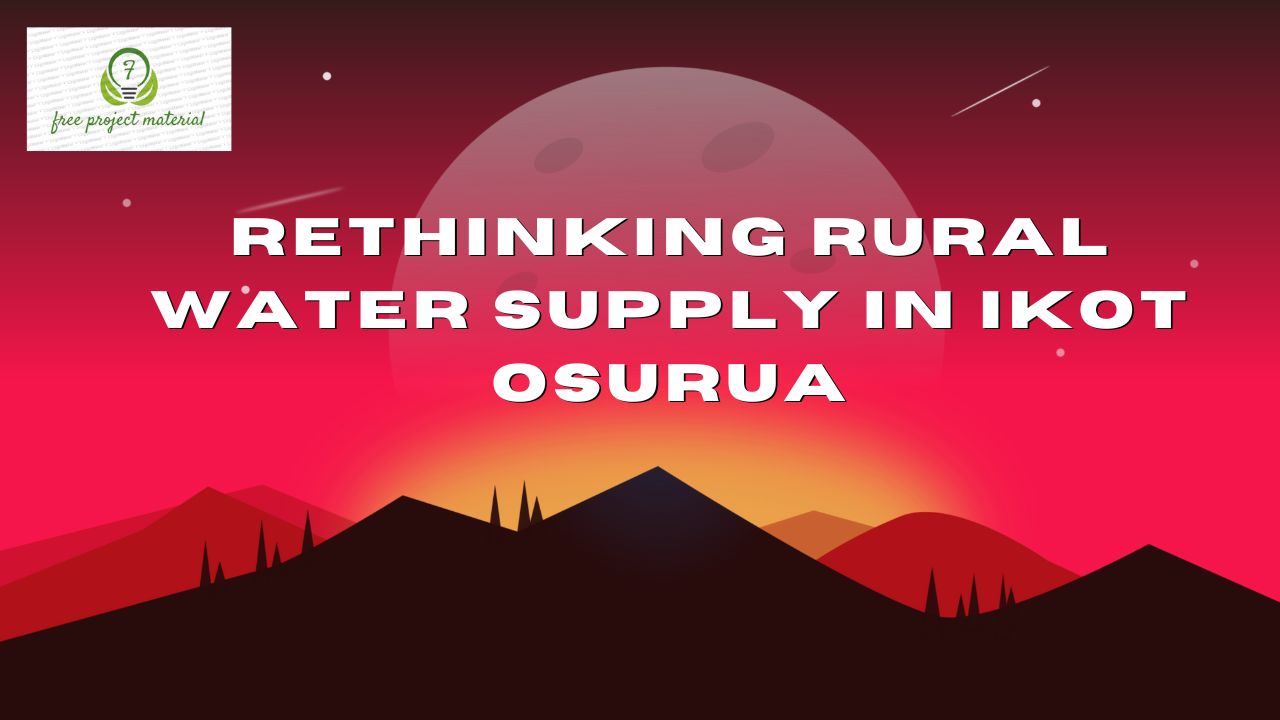ABSTRACT
Water can be defined as a colourless transparent, odourless liquid that forms seas, lakes, rivers and rain and is the basis of the fluids of living organisms. Basically, there are two sources of water supply which is found on the surface of the earth, while groundwater is found in well. Rural water supply is the provision of water by public utilities, commercial organization, community endeavours or individual usually via a system of pumps and pipes. The general objectives of this study is to seek ways of providing more water in Ikot Osurua community. This research project will be of help to communities where fresh water sources such as streams, lakes, ponds are available for drinking and other domestic uses in their vicinity. The government should upgrade the old system and expand it to other areas in Ikot Osurua. in view of increasing population.
TABLE OF CONTENT
Pages
Title page – – – – – – – – – – i
Certification – – – – – – – – – ii
Dedication – – – – – – – – – – iii
Acknowledgement – – – – – – – – – iv
Abstract – – – – – – – – – – v
Table of Content – – – – – – – – – vi-vii
CHAPTER ONE
I.0 Introduction – – – – – – – – – 1
1.1 Background of the Study – – – – – – – 1-4
1.2 Aims and Objectives of the Study – – – – – 5
1.3 Significance of the Study – – – – – – – 5
1.4 Definition of Terms – – – – – – – 6-9
CHAPTER TWO
2.0 Literature Review – – – – – – – – 10
2.1 Forms of Water – – – – – – – – 10-12
2.2 Water Pollution – – – – – – – – 12
2.3 Cause of Water Pollution – – – – – – – 12-13
2.4 Effects of Water Pollution – – – – – – 14
2.5 Types of Water Pollution – – – – – – – 15-16
2.6 Water Treatment – – – – – – – – 16-19
2.7 Historical Development of Rural Water Supply in Nigeria – – 19-21
2.8 Overview of the Current State of Rural Water
Supply in Ikot Osurua – – – – – – – 21-23
2.9 Ways of Improving Rural Water Supplies – – – – 23-25
CHAPTER THREE
3.0 Methods and Discussion – – – – – – – 26
3.1 Introduction – – – – – – – – 26
3.2 Research Design – – – – – – – – 26
3.3 Description of the Study Area – – – – – – 26-27
3.4 Data Collection – – – – – – – – 27
CHAPTER FOUR
4.0 Result and Discussion – – – – – – – 28
4.1 Results – – – – – – – – – 28-29
4.2 The Current Water Supply in Ikot Osurua Village – – – 29-30
CHAPTER FIVE
5.0 Conclusion and Recommendation – – – – – 31
5.1 Conclusion – – – – – – – – – 31
5.2 Recommendation – – – – – – – – 31-32
References
CHAPTER ONE
INTRODUCTION
1.1 BACKGROUND OF THE STUDY
Water generally is the essential item for any living being, it is possible to survive without food and shelter for some days, but without water, it is not possible to survive even for a day. Without air, one cannot be alive even for few minutes. Next to air, it is water which is of utmost importance to living beings. Water is a free gift of nature to human race that is why all ancient civilization developed along the river bank because water was available for drinking, domestic use and also for irrigation. Water for drinking purpose has been appreciated by human race from time immemorial, as a matter of fact, community life developed in the beginning only at places where there was enough water to sustain life. That was the reason why people living in the arid and semi-arid region had to search hard for natural springs. They had to dig wells, construct cisterns to store water, etc.
As the most abundant element among the natural resources, water is critical for the survival of all living organisms including humans, food production and economic development. Today there are many cities worldwide facing an acute shortage of water and nearly 40 percent of the world food supply is grown under irrigation and a wide variety of industrial processes depend on water. The environmental economic growth and development are all highly influenced by water it regional and seasonal availability as well as the quality of surface and ground water.
Hydrological cycle is the movement of water containing basic continuous process like evaporation, precipitation and runoff. This is a continuous cycle which starts with evaporation from the water bodies such as ocean. The water cycle, or hydrologic cycle, refers to the continuous circulation of water within the earth’s hydrosphere. Water moves into the various reservoirs on, over and under the surface of the earth and in the process transforms into its various phases of solid (ice), liquid (water), and gas (vapour), with the total mass of water remaining fairly constant. The physical processes of evaporation, precipitation, condensation, sublimation transportation and runoff are responsible for sustaining the water cycle. Heat energy is also exchanged during the cycle, with this store and release of heat affecting climates worldwide.
The water cycle is highly crucial to maintaining life of earth, as it replenishes the world’s freshwater resources and moderates extremes in climate. Uses of water, of course some of the important uses of water are at our homes. Domestic water use is water used for indoor/outdoor household purpose all the things one do at homes drinking, preparing food, bathing, washing clothes and dishes, brushing of teeth, watering the yard and garden.
Commercial water use includes fresh water for motels, hotels, restaurants, office building, other commercial facilities and civilian and military institutions. Domestic water use is probably the most important daily use of water for most people.
Industrial water use is a valuable resource to the nation’s industries for such purpose as processing, cleaning, transportation, dilution, and cooling in manufacturing facilities. Major water using industries include steel, chemical, paper, and petroleum refining. Industries often reuse some water over and over for more than one purpose.
Irrigation water use is water artificially applied to farm, orchard, pasture, and horticultural crops, as well as water used to irrigate pastures, for forest and freeze protection, chemical application, crop, cooling, harvesting and foe, the leaching of salts from the crop root zone. Non-agricultural activities include self-supplied water to irrigate public and private golf courses, parts.
Livestock water use include water for animals stock, feed lots, dairies, fish farms, and other non-farm needs. Water is needed for the production of red meat, poultry, egg, milk, and wool and for horses, rabbits, and pets, livestock water uses only includes fresh water. Public water supply use refers to water withdrawn by public and private water suppliers, such as county and municipal water works and delivered to use for domestic, commercial and industrial purposes.
In 1995, the majority of the nation’s population, about 225 million, or 82 percent, used water delivered form public water supply. About 42 million people supplied their own water, with about 99 percent of that water being groundwater, usually from a local well.
Thermoelectric power water use is the amount of water used in production of electric water used in production of electric power generated with heat. The source of the heat may be from fossil fuel power plants typically reuse water.
Sources of Water:
Water is a vital element in each of our lives, not only is it essential to our health, but we also need it for numerous household tasks. Every day we use water for cooking, bathing, cleaning and drinking.
There are two main sources of water; surface water and groundwater.
- Surface water is found in lakes, rivers and reservoirs.
- Groundwater lies under the surface of the land where it travels through and fills openings in the rocks. The rocks that store and transmit ground water to the earth surface for use are called aquifer, e.g springs, wells.
1.2 AIMS AND OBJECTIVES OF THE STUDY
- To make water readily availability to users in order to encourage personal and house hold hygiene.
- To provide more treated water in the community for adequate use by the inhabitants.
1.3 SIGNIFICANCE OF THE STUDY
The research would also be of help to communities that are involved in farming to enhance irrigation practices in their vicinity.
This will help create link for investors to come into the community and also meaningful links to other relevant stakeholders.
This study would serve as a reference materials for future researches by the students who may be interested in carrying our further research on water supply or related topic.
It will be of good benefit to small scale enterprises.
1.4 DEFINITION OF TERMS
AQUICLUDE: This a geological formation that is essentially impermeable.
AQUIFER: Is porous and permeable geological formation capable of storing and yielding water in sufficient quantity.
AQUIFUGE: An impervious geological formation which neither contains water nor transmits water is known as aquifuge. A solid granite rock is an example of aquifuge.
AQUITARD: This a geological formation the is less permeable that an aquifer.
ARTESIAN WELL: If the water in a well in a confined aquifer rises above the top of the aquifer the well is an artesian well.
BRINE: This is a water that is saturated of partially saturated water salt.
CAPILLARY WATER: This water remains in the soil as thin continuous soil particles. It is held by surface tension and moved by capillary action within soil particles.
CONDENSATION: It is the conversion of a vapour or gas to a liquid.
CONNATE WATER: Is the type of water entrapped in sedimentary rock during the sedimentation process.
GRAVITATIONAL WATER: Gravitational water is water that flows due to the action of gravity. Thin water is loosely contained in the soil and has a free surface which is horizontal and moves in the direction of lower energy.
GROUNDWATER ZONES: The amount of water that infiltrates into the ground depend on how precipitation is dispersed; what proportion by volume is assigned to run-off and evapotranspiration, the remainder constituting the proportion of water that will infiltrate into the soil.
GROUNDWATER: Is one of the earth’s most widely distributed resources and is increasingly catering for requirement of the domestic, industrial and agricultural sectors.
HYDROLOGIC CYCLE: Is the movement of water from the land to the ocean, to the atmosphere and back to the land.
HYGROSCOPIC WATER: This water is absorbed from the atmosphere and form thin film on the soil particles. This water adheres to soil particles and is difficult to separate from soil particles.
JUVENILE WATER: This is also called magmatic eater during cooling of magma, its gaseous vapour separates from it vapour, which is gradually condensed into superheated water and moves up to low temperature and pressure.
LEAKY AQUIFER: An aquifer bound by one or two aquitaids is called a leaky aquifer or semi-confined aquifer.
METEORIC WATER: This includes water derived from atmospheric precipitation in the form of rainfall, sleet, hail, snow, etc. by the infiltration of water by surface water bodies such as rivers, reservoirs, lakes etc.
PERCHED AQUIFER: When a groundwater body is separated from the main groundwater by relatively a small impermeable stratum of a aeration above the main body of groundwater it is called perched aquifer.
PUMPING STATION: This can be defined as facilities provided for water supply in the absence of gravity flow, treated water is supplied to a distribution network water or storage reservoir.
RUNOFF: This is the portions or amount of precipitation on an area which does not infiltrate or evaporate but instead is discharge from one area.
RURAL: Means pertaining to less populated no-urban areas.
SPRING: A place where water comes naturally to the surface from under the ground.
STORAGE COEFFICIENT: The storage coefficient is defined as the volume of water that an aquifer releases from or takes into storage per unit surface area of the aquifer per unit drop of water table in the case of an unconfined aquifer.
SUPPLY: This can be defined as the act of providing or the make something available for users.
TOPOGRAPHY: this affects run-off and infiltration steep slope ground activates more run-off water and less infiltration. In another situation a gentle slope region facilities more or less equal run-off and filtration.
WATER: Water is one of the most common substance known. It is a good solvent for many substances and rarely occurs in its pure form in nature.
WELL: This is a develop hole in the ground from which people obtain water.



